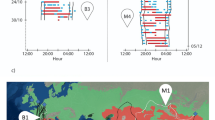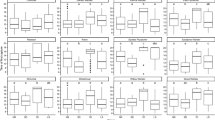Abstract
The scale of movements that passerine migrants perform during stopover is an important parameter of avian stopover ecology and behaviour. The scale of daytime movements has been estimated by captures of losing track of individuals that perform the longest movements. To estimate the upper limit of such daytime movements, I analysed recaptures of six nocturnal passerine migrant species between two trapping sites on the Courish Spit in the Eastern Baltic located 10.7 km apart. The proportion of birds that covered this distance during the daytime varied between species and seasons, but was generally very low, varying between 0 and 0.140%. Ten kilometres appears to be at the very upper limit of the distance covered by nocturnal migrants during their daytime movements, with the bulk of birds remaining within a much smaller area. No evidence supports the view that, in the daytime, nocturnal migrants significantly prefer to move in the migratory direction, even on the Courish Spit which runs along the migratory route of most passerine migrants in the area.
Zusammenfassung
Das Ausmaß der Ortsveränderungen, die ziehende Singvögel auf Stopovers zeigen, ist ein wichtiger Parameter in der Rastplatzökologie und dem Verhalten von Zugvögeln. Der Umfang solcher Bewegungen während des Tages ist bislang anhand von Fängen und Wiederfängen an ein und demselben Ort geschätzt worden, was zu ernsthaften Unterschätzungen geführt haben mag. Diese Gefahr besteht ebenso bei der Verfolgung von Tieren durch Sender, weil bei beiden Methoden die Wahrscheinlichkeit recht hoch ist, daß man diejenigen Individuen, die sich über die längsten Distanzen bewegen, bei der Nachverfolgung verliert. Um die Obergrenze solcher Ortsveränderungen untertags abzuschätzen, analysierte ich die Wiederfänge von sechs nächtlich ziehenden Singvogelarten zwischen zwei 10,7 km voneinander entfernten Fangstellen auf der Kurischen Nehrung, Baltikum. Der Anteil an Individuen, die diese Strecke untertags zurücklegten, variierte von Art zu Art und von Jahreszeit zu Jahreszeit, war aber generell sehr gering und bewegte sich zwischen 0 und 0,140%. Zehn Kilometer scheinen die äußerste Entfernung zu sein, die Nacht-Zieher bei ihren Ortsveränderungen untertags zurücklegen, wobei sich der größte Teil der Vögel innerhalb wesentlich engerer Grenzen bewegt. Es gibt keine Hinweise darauf, daß Nacht-Zieher bei ihren Ortsveränderungen untertags eine klare Tendenz hätten, sich in Zugrichtung zu bewegen, nicht einmal auf der Kurischen Nehrung, die genau in Zugrichtung der meisten Singvögel der Gegend verläuft.

Similar content being viewed by others
References
Aborn DA, Moore FR (1997) Pattern of movement by summer tanagers (Piranga rubra) during migratory stopover: a telemetry study. Behaviour 134:1077–1100
Adamska K, Filar M (2005) Directional preferences of the Chiffchaff (Phylloscopus collybita) and the Robin (Erithacus rubecula) on autumn migration in the Beskid Niski Mountains (S Poland). Ring 27:159–176
Alerstam T, Lindström Å (1990) Optimal bird migration: the relative importance of time, energy, and safety. In: Gwinner (ed) Bird migration. Springer, Berlin, pp 331–351
Bastian A (1992) Mobilität von Kleinvögeln in einem süddeutschen Rastgebiet während der Wegzugperiode. Ökol Vögel 12:121–163
Bolshakov CV (1977) Study of nocturnal bird migration (methodological aspect). In: Ilyichev VD (ed) Methods of bird migration research (Proceedings of all-Soviet research school). Moscow: Nauka, pp 77–96 [in Russian]
Bolshakov CV, Dolnik VR (2001) A review of research at the Biological Station Rybachy in 1956–2000. Avian Ecol Behav 6:5–8
Bolshakov CV, Shapoval AP, Zelenova NP (2001) Results of bird ringing by the Biological Station “Rybachy” on the Courish Spit: long-distance recoveries of birds ringed in 1956–1997. Part 1. Avian Ecol Behav Suppl 1:1–126
Bolshakov CV, Shapoval AP, Zelenova NP (2002) Results of bird ringing by the Biological Station “Rybachy”: controls of birds ringed outside the Courish Spit in 1956–1997. Part 1. Avian Ecol Behav Suppl 5:1–106
Busse P (1995) New technique of a field study of directional preferences of night passerine migrants. Ring 17:51–75
Busse P, Gavrilov VM, Ivliev V, Nowakowski JK (2001) Differentiation of directional preferences of some nocturnal migrants on autumn migration across the central and eastern Europe. Ring 23:119–130
Chernetsov N (2005) Spatial behavior of medium and long-distance migrants at stopovers studied by radio tracking. Ann NY Acad Sci 1046:242–252
Chernetsov N, Bolshakov CV (2006) Spatial behavior of some nocturnal passerine migrants during stopovers. Acta Zool Sin 52(Suppl):599–601
Chernetsov N, Mukhin A (2006) Spatial behaviour of European robins Erithacus rubecula during migratory stopovers: a telemetry study. Wilson J Ornithol 118:364–373
Chernetsov N, Titov N (2000) Design of a trapping station for studying migratory stopovers by capture-mark-recapture analysis. Avian Ecol Behav 5:27–33
Chernetsov N, Mukhin A, Ktitorov P (2004) Contrasting spatial behaviour of two long-distance passerine migrants at spring stopovers. Avian Ecol Behav 12:53–61
Dorka V (1966) Das jahres- und tageszeitliche Zugmuster von Kurz- und Langstreckenziehern nach Beobachtungen auf den Alpenpässen Cou/Bretolet (Wallis). Orn Beob 63:165–223
Emlen ST, Emlen JT (1966) A technique for recording migratory orientation of captive birds. Auk 83:361–367
Hedenström A (2008) Adaptations to migration in birds: behavioural strategies, morphology and scaling effects. Philos Trans R Soc Lond B 363:287–299
Kramer G (1949) Über Richtungstendenzen bei der nächtlichen Zugunruhe gekäfigter Vögel. In: Mayr E, Schüz E (Hrsg) Ornithologie als biologische Wissenschaft. Winter, Heidelberg, pp 269–283
Ktitorov P, Bairlein F, Dubinin M (2008) The importance of landscape context for songbirds on migration: body mass gain is related to habitat cover. Landsc Ecol 23:169–179
Ktitorov P, Tsvey A, Mukhin A (2010) The good and the bad stopover: behaviours of migrant reed warblers at two contrasting sites. Behav Ecol Sociobiol 64:1135–1143
Moore FR (1986) Sunrise, skylight polarization and the early morning orientation of night migrating warblers. Condor 88:493–498
Moore FR (1990) Evidence for redetermination of migratory direction following wind displacement. Auk 107:425–428
Moore FR, Woodrey MS, Buler JJ, Woltmann S, Simons TR (2005) Understanding the stopover of migratory birds: a scale-dependent approach. In: Ralph CJ, Rich TD (eds) Bird conservation implementation and integration in the Americas: Proceedings of the 3rd international partners in flight conference 2002. USDA, Forest Service General Technical Report PSW-191
Mouritsen H (1998) Redstarts, Phoenicurus phoenicurus, can orient in a true-zero magnetic field. Anim Behav 55:1311–1324
Newton I (2008) The migration ecology of birds. Academic, London
Ożarowska A, Yosef R, Busse P (2004) Orientation of chiffchaff (Phylloscopus collybita), blackcap (Sylvia atricapilla) and lesser white-throat (S. curruca) on spring migration at Eilat, Israel. Avian Ecol Behav 12:1–10
Payevsky VA (1973) Atlas of bird migration according to banding data at the Courland spit. In: Bykhovskii BE (ed) Bird migration–ecological and physiological factors. Wiley, New York, pp 1–124
Payevsky VA (1999) Breeding biology, morphometrics, and population dynamics of Sylvia warblers in the Eastern Baltic. Avian Ecol Behav 2:19–50
Payevsky VA (2000) Rybachy-type trap. In: Busse P (ed) Bird Station Manual. Gdańsk University Press, Gdańsk, pp 20–24
Schmaljohann H, Becker PJJ, Karaardic H, Liechti F, Naef-Daenzer B, Grande C (2011) Nocturnal exploratory flights, departure time, and direction in a migratory songbird. J Ornithol 152:439–452
Wiedner DS, Kerlinger P, Sibley DA, Holt P, Hough J, Crossley R (1992) Visible morning flights of Neotropical landbird migrants at Cape May, New Jersey. Auk 109:500–510
Wiens JA (1989) Spatial scaling in ecology. Funct Ecol 3:385–397
Wikelski M, Tarlow EM, Raim A, Diehl RH, Larkin RP, Visser GH (2003) Costs of migration in free-flying songbirds. Nature 423:704
Acknowledgments
The author is most grateful to all persons, too numerous to name, who participated in the trapping projects run by the Biological Station Rybachy in Rybachy and Fringilla. All ringing operations and handling protocols complied with the current laws of Russian Federation. The author is also grateful to Heiko Schmaljohann and two anonymous reviewers whose insightful comments helped to improve an earlier draft. At the stage of data analysis, this study was supported by the Russian Foundation for Basic Research (grant no. 09-04-00208a).
Author information
Authors and Affiliations
Corresponding author
Additional information
Communicated by F. Bairlein.
Rights and permissions
About this article
Cite this article
Chernetsov, N. Daytime movements of nocturnal migrants at stopover between two nearby capture sites. J Ornithol 152, 1007–1011 (2011). https://doi.org/10.1007/s10336-011-0690-5
Received:
Revised:
Accepted:
Published:
Issue Date:
DOI: https://doi.org/10.1007/s10336-011-0690-5




